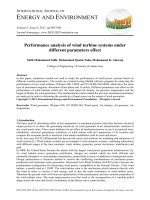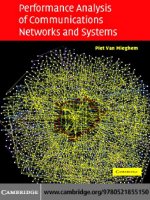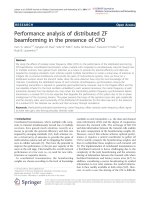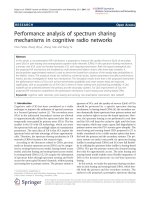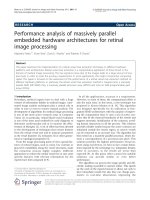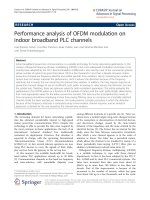Performance analysis of diversity wireless systems
Bạn đang xem bản rút gọn của tài liệu. Xem và tải ngay bản đầy đủ của tài liệu tại đây (683.09 KB, 171 trang )
PERFORMANCE ANALYSIS OF DIVERSITY WIRELESS
SYSTEMS
CAO LE
NATIONAL UNIVERSITY OF SINGAPORE
2011
PERFORMANCE ANALYSIS OF DIVERSITY WIRELESS
SYSTEMS
CAO LE
(M. Sc., National University of Singapore)
A THESIS SUBMITTED
FOR THE DEGREE OF DOCTOR OF PHILOSOPHY
DEPARTMENT OF ELECTRICAL AND COMPUTER ENGINEERING
NATIONAL UNIVERSITY OF SINGAPORE
2011
Acknowledgement
During my PhD studies, I have worked with my supervisors and colleagues who have
contributed in assorted ways to the research and this thesis. This thesis would not
have been possible without their unconditionally kind support. I am more than glad to
convey my gratitude to them all in my humble acknowledgment.
In the first place, my sincere gratitude and appreciation undoubtedly go to my
supervisor, Professor Kam Pooi Yuen for his supervision, advice, and guidance. Above
all and the most important, he provided me unflinching encouragement and support in
various ways. It is he who gives me a compass and an interesting book along my
research journey. His truly scientific intuition has made him as a constant oasis of
ideas and passions in science, which exceptionally inspire and enrich my growth as a
student, a researcher and a scientist-to-be. I am indebted to him more than he knows.
Secondly, I would like to record my gratitude to Dr. Tao Meixia for her supervision,
advice, and guidance in the very early stage of my research journey. Her involvement
in the detailed work has triggered and nourished my intellectual maturity that I benefit
from.
Collective and individual acknowledgments are also owed to my colleagues at
ECE-I2R Wireless Communications Lab whose presence are somehow perpetually
refreshing, helpful, and memorable. Many thanks go to Dr. Zhu Yonglan for her
valuable suggestions, sharing various thoughts, and patient discussions. I would like
to thank Mr. Siow Hong Lin, Eric for the technical support to our lab. Many thanks
i
Acknowledgement
go in particular to Dr. Li Yan, Dr. Cao Wei, Dr. Gao Feifei and Dr. Jiang Jianhua
for giving me a lot of constant help and advice for my study life and living life since I
began my studies in NUS. It is a pleasure to mention: Dr. Lu Yang, Dr. Zhang Xiaolu,
Dr. Hou Shengwei, Mr. Chen Qian, Ms. Wu Mingwei, Dr. Shao Xuguang and Mr.
Lin Xuzheng for creating such a great friendship at the lab and spending wonderful
and memorable time at lunch. Thanks to Ms. Zhou Xiaodan for being such a good
colleague and neighbor. I did not feel lonely any more on the one-hour way back home
since we became neighbors. It is a pleasure to mention Ms. Tian Zhengmiao who is
one of my fellow alumni of Xidian University, China. I am more than happy to become
her colleague again at NUS. I also would like to thank Dr. Zhang Qi, Dr. Elisa Mo,
Mr. Kang Xin, Mr. Yuan Haifeng, Dr. Mahtab Hossain, Dr. Nitthita Chirdchoo and
Dr. Pham The Hanh for giving me such a pleasant time when working at the same lab.
Where would I be without my family? My parents deserve special mention for
their inseparable and everlasting support and love. My father, in the first place, is the
person who showed me the joy of intellectual pursuit ever since I was a child. My
mother is the one who sincerely raised me with her tender care and endless love. Her
understanding and support encourage me to work hard and to continue my studies
abroad. Her firm and kind-hearted personality has affected me to be steadfast and
never bend to difficulties. Last but not least, I am greatly indebted to my devoted
husband. He is the backbone and origin of my happiness. His unconditional love,
support, company and encouragement make me dedicated to what I want to do. I am
so grateful for his presence in my life.
Finally, the support of Singapore MoE AcRF Tier 2 Grant T206B2101 in the
form of research scholarship is gratefully acknowledged.
ii
Contents
Acknowledgement i
Contents iii
Summary vii
List of Figures ix
Abbreviations xii
Notations xiv
Chapter 1. Introduction 1
1.1 Introduction to Diversity Wireless Systems . . . . . . . . . . . . . . . 1
1.1.1 MIMO Systems . . . . . . . . . . . . . . . . . . . . . . . . . 2
1.1.2 ARQ/HARQ Systems . . . . . . . . . . . . . . . . . . . . . 3
1.2 Motivations of the Work . . . . . . . . . . . . . . . . . . . . . . . . 4
1.2.1 MIMO Systems . . . . . . . . . . . . . . . . . . . . . . . . . 4
1.2.2 ARQ/HARQ Systems . . . . . . . . . . . . . . . . . . . . . 6
1.3 Research Objectives and Contributions . . . . . . . . . . . . . . . . . 8
1.4 Organization of the Thesis . . . . . . . . . . . . . . . . . . . . . . . 11
Chapter 2. Literature Review 13
2.1 MIMO Systems . . . . . . . . . . . . . . . . . . . . . . . . . . . . . 13
2.1.1 Information Theoretic Performance Limits . . . . . . . . . . 13
2.1.2 Optimal Transmission Strategies . . . . . . . . . . . . . . . . 16
2.2 ARQ/HARQ Systems . . . . . . . . . . . . . . . . . . . . . . . . . . 19
2.2.1 Background of ARQ/HARQ Systems . . . . . . . . . . . . . 19
2.2.2 Performance of Packet ARQ/HARQ Schemes . . . . . . . . . 23
iii
Contents
2.2.3 Adaptive Transmission Strategies . . . . . . . . . . . . . . . 24
Chapter 3. On the Ergodic Capacity of MIMO Rayleigh Fading Channels 26
3.1 Introduction . . . . . . . . . . . . . . . . . . . . . . . . . . . . . . . 26
3.2 System Description . . . . . . . . . . . . . . . . . . . . . . . . . . . 28
3.3 Trace Bounds . . . . . . . . . . . . . . . . . . . . . . . . . . . . . . 29
3.3.1 Upper bound . . . . . . . . . . . . . . . . . . . . . . . . . . 29
3.3.2 Lower bounds . . . . . . . . . . . . . . . . . . . . . . . . . . 32
3.4 Determinant Bound . . . . . . . . . . . . . . . . . . . . . . . . . . . 32
3.5 Simulation and Numerical Results . . . . . . . . . . . . . . . . . . . 34
3.5.1 Trace bounds and determinant bound . . . . . . . . . . . . . 34
3.5.2 Optimum Antenna Deployment . . . . . . . . . . . . . . . . 37
3.6 Conclusions . . . . . . . . . . . . . . . . . . . . . . . . . . . . . . . 39
Chapter 4. Power Control for MIMO Diversity Systems with Non-Identical
Rayleigh Fading Channels 40
4.1 System Model . . . . . . . . . . . . . . . . . . . . . . . . . . . . . . 42
4.2 Ergodic Mutual Information and Power Allocation . . . . . . . . . . 44
4.2.1 Ergodic mutual information analysis . . . . . . . . . . . . . . 44
4.2.2 Power Allocation for Two-Transmit One-Receive Antenna
Systems . . . . . . . . . . . . . . . . . . . . . . . . . . . . . 45
4.2.3 Power Allocation for Multiple-Transmit One-Receive Antenna
Systems . . . . . . . . . . . . . . . . . . . . . . . . . . . . . 49
4.3 Information Outage Probability and Power Allocation . . . . . . . . . 51
4.4 Numerical Results . . . . . . . . . . . . . . . . . . . . . . . . . . . . 53
4.5 An Application of Our Results . . . . . . . . . . . . . . . . . . . . . 58
4.6 Conclusions . . . . . . . . . . . . . . . . . . . . . . . . . . . . . . . 63
Chapter 5. Performance of ARQ/HARQ Schemes With Imperfect CSIR
Over Rayleigh Fading Channels 65
5.1 Introduction . . . . . . . . . . . . . . . . . . . . . . . . . . . . . . . 66
5.2 System Description . . . . . . . . . . . . . . . . . . . . . . . . . . . 69
5.3 Basic ARQ with BPSK/QPSK in SIMO Systems with Imperfect CSIR 73
5.3.1 Bit Error Probability . . . . . . . . . . . . . . . . . . . . . . 73
iv
Contents
5.3.2 Packet Error Probability . . . . . . . . . . . . . . . . . . . . 74
5.3.3 Undetectable Error Rate . . . . . . . . . . . . . . . . . . . . 75
5.3.4 Selective-repeat ARQ scheme . . . . . . . . . . . . . . . . . 77
5.3.5 Stop-and-wait ARQ scheme . . . . . . . . . . . . . . . . . . 79
5.3.6 Go-back-N ARQ scheme . . . . . . . . . . . . . . . . . . . 80
5.3.7 Power Allocation between Pilot and Data Bits . . . . . . . . . 81
5.3.8 Numerical Results for Basic ARQ Schemes . . . . . . . . . . 83
5.4 Type-I HARQ with BPSK/QPSK in SIMO Systems with Imperfect CSIR 88
5.4.1 Selective-repeat based Type-I HARQ scheme . . . . . . . . . 90
5.4.2 Stop-and-wait based Type-I HARQ scheme . . . . . . . . . . 92
5.4.3 Go-back-N based Type-I HARQ scheme . . . . . . . . . . . . 93
5.4.4 Numerical Results for Type-I HARQ . . . . . . . . . . . . . 94
5.5 Basic ARQ with BDPSK in SIMO Systems . . . . . . . . . . . . . . 103
5.5.1 Packet Error Probability . . . . . . . . . . . . . . . . . . . . 105
5.5.2 Goodput Analysis of ARQ Schemes . . . . . . . . . . . . . . 109
5.5.3 Simulation and Numerical Results . . . . . . . . . . . . . . . 113
5.6 Conclusions . . . . . . . . . . . . . . . . . . . . . . . . . . . . . . . 116
Chapter 6. Goodput-Optimal Rate Adaptation with Imperfect CSIT and
CSIR 117
6.1 Introduction . . . . . . . . . . . . . . . . . . . . . . . . . . . . . . . 117
6.2 System Model . . . . . . . . . . . . . . . . . . . . . . . . . . . . . . 119
6.3 PSAM Scheme with Channel Prediction and Channel Estimation . . . 119
6.3.1 Channel Estimation . . . . . . . . . . . . . . . . . . . . . . . 120
6.3.2 Channel Prediction . . . . . . . . . . . . . . . . . . . . . . . 121
6.3.3 The Relationship Between Channel Estimation and Prediction 122
6.4 Goodput-Optimal Rate Allocation . . . . . . . . . . . . . . . . . . . 124
6.4.1 Optimal Solution λ
∗
o
. . . . . . . . . . . . . . . . . . . . . . 125
6.4.2 Approximation of λ
∗
o
. . . . . . . . . . . . . . . . . . . . . . 126
6.5 Numerical Results . . . . . . . . . . . . . . . . . . . . . . . . . . . . 127
6.6 Conclusions . . . . . . . . . . . . . . . . . . . . . . . . . . . . . . . 130
Chapter 7. Conclusions and Future Work 132
7.1 Conclusions . . . . . . . . . . . . . . . . . . . . . . . . . . . . . . . 132
v
Contents
7.2 Future Work . . . . . . . . . . . . . . . . . . . . . . . . . . . . . . . 137
7.2.1 Effects of Imperfect CSIR on MIMO Systems . . . . . . . . . 137
7.2.2 Transmission Strategies in MIMO Systems with Imperfect
CSIR and Outdated CSIT . . . . . . . . . . . . . . . . . . . 137
7.2.3 Extension of HARQ with Diversity Combining to Code
Combining . . . . . . . . . . . . . . . . . . . . . . . . . . . 138
7.2.4 Adaptive Transmission in HARQ Schemes with Imperfect
CSIT/CSIR . . . . . . . . . . . . . . . . . . . . . . . . . . . 138
Bibliography 140
Appendix A. Proof of the Inequality (3.8) 151
Appendix B. Proof of the equation (5.12) 153
List of Publications 154
vi
Summary
Many wireless communication systems make use of the diversity technique: a
well-known concept to combat the effects of multipath fading. Diversity reception
consists of receiving redundantly the same information-bearing signal over multiple
fading channels, (then combining them at the receiver so as to increase the received
signal-to-noise ratio (SNR).)
One way by which these multiple replicas can be obtained is using multiple
antennas in multiple-input-multiple-output (MIMO) systems for achieving space
diversity. The ergodic capacity is a key performance parameter of a MIMO fading
channel. We obtain tight bounds on the ergodic capacity over an identical MIMO
fading channel, which show explicitly the dependency of the ergodic capacity on
the SNR and the number of transmit and receive antennas. The results enable us to
determine the optimal number of transmit antennas to be used for a given SNR and a
given total number of antennas. Recently, MIMO systems over a non-identical fading
channel have attracted great attention because of their applications in cooperative
communications and distributed antenna systems. We derive explicit and closed-form
expressions of the ergodic mutual information (MI) and the information outage
probability. Two simple and near-optimal power-allocation schemes are then proposed
for maximizing the ergodic MI and minimizing the information outage, respectively.
Another approach to obtain multiple replicas of the same information-bearing
signal is by using multiple time slots separated by at least the coherence time of
vii
Summary
the channel in automatic-repeat-request (ARQ) systems, leading to the exploitation
of time diversity. With imperfect channel state information at the receiver (CSIR),
the performance parameters of ARQ systems are evaluated as a function of the
accuracy of the channel estimation. A link between data-link-layer performances
and physical-layer parameters is therefore established. An attempt is made to study
the inter-relationships among the various relevant system performance parameters
and the dependency of these relationships on the CSIR accuracy. For enhancing
the throughput, adaptive transmission strategies have been adopted to match the
transmission rate to time-varying channel conditions for achieving higher spectral
efficiency. Therefore, with regard to maximizing the throughput, in addition to
providing a more reliable transmission, ARQ schemes with adaptive transmissions
are extensively adopted. Considering a practical case with the imperfect channel
state information at the transmitter (CSIT) and the imperfect CSIR, an optimal
continuous-rate adaptation scheme is studied so as to achieve a maximum goodput.
viii
List of Figures
3.1 Bounds on the average MI of MIMO Rayleigh channels with N = 2
and M = 3. . . . . . . . . . . . . . . . . . . . . . . . . . . . . . . . 35
3.2 Bounds on the average MI of MIMO Rayleigh channels with N = 4
and M = 5. . . . . . . . . . . . . . . . . . . . . . . . . . . . . . . . 36
3.3 Optimum N for achieving the maximum ergodic capacity (N+M=7). . 37
3.4 Optimum N for achieving the maximum ergodic capacity (N+M=11). 38
4.1 Power functions for a diversity system with two transmit antennas and
one receive antenna . . . . . . . . . . . . . . . . . . . . . . . . . . . 50
4.2 Ergodic mutual information with different power allocations . . . . . 54
4.3 Outage probability with different power allocations. . . . . . . . . . . 55
4.4 Power values using different criteria under channel condition 1. . . . . 56
4.5 Power values using different criteria under channel condition 2. . . . . 57
4.6 Outage probability with different power allocations. . . . . . . . . . . 58
4.7 Wireless cooperative relay diversity system which can represent three
different systems: system 1 (solid line), system 2 (dash line) and
system 3 (solid line and dash line) . . . . . . . . . . . . . . . . . . . 59
4.8 Ergodic mutual information using different power allocation in system
1 and 2 with N = 3 and M = 1. . . . . . . . . . . . . . . . . . . . . 60
4.9 The power values assigned on relay II and source for maximizing the
ergodic mutual information in system 1 and 2 with N = 3 and M = 1. 61
4.10 Outage probability with different power allocations in systems 1 and 2
with N = 3 and M = 1, and system 3 with N = 3 and M = 2. . . . . 62
ix
List of Figures
4.11 The power values assigned on relay II and source for minimizing the
outage in systems 1 and 2 with N = 3 and M = 1, and system 3 with
N = 3 and M = 2. . . . . . . . . . . . . . . . . . . . . . . . . . . . 63
5.1 The APER versus the normalized MSE and E
a
/N
0
. . . . . . . . . . . 84
5.2 The goodput versus the normalized MSE and the APER. . . . . . . . 85
5.3 The value of ε
∗
versus average SNR per bit E
a
/N
0
. . . . . . . . . . 86
5.4 The lower bound on the goodput achieved by different values of ε . . 87
5.5 The APER versus the NMSE for basic ARQ without packet combining
(w/o comb.) and Type-I HARQ with packet combining (w/ comb.) . . 95
5.6 The APER versus the effective received SNR per bit for basic ARQ
(w/o comb.) and Type-I HARQ (w/ comb.) . . . . . . . . . . . . . . . 96
5.7 The goodput versus the NMSE for SR, GBN, and SW based Type-I
HARQ with N = 10. . . . . . . . . . . . . . . . . . . . . . . . . . . 97
5.8 The goodput versus the effective received SNR per bit for Type-I
HARQ schemes with N = 10. . . . . . . . . . . . . . . . . . . . . . 98
5.9 The number of necessary transmissions for achieving a drop rate less
than 10
−8
and 10
−6
for Type-I HARQ versus the NMSE. . . . . . . . 99
5.10 The comparison of lower bounds on goodput of Type-I HARQ
schemes with BPSK and QPSK when L = 2. . . . . . . . . . . . . . 100
5.11 The comparison of the necessary number of transmissions of Type-I
HARQ with BPSK and QPSK for achieving a drop rate less than 10
−6
. 101
5.12 The PEP versus the average SNR ¯γ
s
with a single receive antenna. . . 111
5.13 The goodput versus the average SNR ¯γ
s
with a single receive antenna. 112
5.14 The PEP versus the average SNR ¯γ
s
when ρ = 1. . . . . . . . . . . . 113
5.15 The goodput of GBN-ARQ versus the average SNR ¯γ
s
when ρ = 1. . 114
6.1 The optimal utilization factor versus Rician factor K for different
transmit SNR with different accuracy of channel estimation and
prediction. . . . . . . . . . . . . . . . . . . . . . . . . . . . . . . . . 128
x
List of Figures
6.2 The goodput achieved by different utilization factors versus Rician
factor K with 2σ
2
ε
= 10
−2
, 2σ
2
e
= 10
−1
and E
s
/N
0
= 5 dB. . . . . . . 129
6.3 The goodput achieved by λ
∗
o
versus K for different transmit SNR and
different accuracy of channel estimation and prediction. . . . . . . . 130
xi
Abbreviations
ACK Positive Acknowledgement
ARQ Automatic-Repeat-Request
APER Accepted Packet Error Rate
AWGN Additive White Gaussian Noise
BEP Bit Error Probability
BPSK Binary Phase Shift Keying
BSC Binary Symmetric Channel
CCDF Complementary Cumulative Distribution Function
CDF Cumulative Distribution Function
CRC Cyclic Redundancy Check
CSI Channel State Information
CSIT Channel State Information at the Transmitter
CSIR Channel State Information at the Receiver
DBPSK Differential Binary Phase Shift Keying
DF Decode-and-Forward
DPSK Differential Phase Shift Keying
FEC Forward-Error-Control
HARQ Hybrid ARQ
i.i.d Independent and Identically Distributed
xii
Abbreviations
i.n.d Independent and Non-identically Distributed
IR Incremental Redundancy
MAP Maximum A Posteriori
MAC Medium Access Control
MI Mutual Information
MISO Multiple-Input-Single-Output
MIMO Multiple-Input-Multiple-Output
ML Maximum-Likelihood
MMSE Minimum Mean Square Error
M-QAM M-Quadrature Amplitude Modulation
MRC Maximal Ratio Combiner
MSE Mean Square Error
NAK Negative Acknowledgment
OSTBC Orthogonal Space-Time Block Codes
PDF Probability Distribution Function
PEP Packet Error Probability
PSAM Pilot Symbol Assisted Modulation
QPSK Quadrature Phase Shift Keying
SIMO Single-Input-Multiple-Output
SISO Single-Input-Single-Output
SNR Signal-to-Noise Ratio
STBC Space-Time Block Codes
TISO Two-Input-Single-Output
xiii
Notations
In this dissertation, scalar variables are written as plain lower-case letters, vectors as
bold-face lower-case letters, and matrices as bold-face upper-case letters. Some further
used notations and commonly used acronyms are listed in the following:
a plain lower-case to denote scalars
a boldface lower-case to denote column vectors
A boldface upper-case to denote matrices
I
N
the N ×N identity matrix
(·)
∗
the conjugate operation
(·)
T
the transpose operation
(·)
H
the conjugate transpose operation
det(·) the determinant of a matrix
tr(·) the trace of a matrix
E(·) the statistical expectation operation
ℜ(·) the real part of the argument
⊗ the Kronecker product
∥ ·∥
2
F
the Frobenius norm square
erfc(·) the complementary error function
Γ(·) the Gamma function
Γ(·, ·) the upper incomplete Gamma function
xiv
Notations
I
m
(·) the m-th order modified Bessel function of the first kind
K
m
(·) the m-th order modified Bessel function of the second kind
Q
1
(·, ·) the first order Marcum Q-function
Q
m
(·, ·) the generalized Marcum Q-function
xv
Chapter 1
Introduction
1.1 Introduction to Diversity Wireless Systems
Many of the current and emerging wireless communication systems make use in one
form or another of diversity: a classic and well-known concept [1–4] that has been
used since the early 1950’s to combat the effects of multipath fading. Diversity
combining consists of receiving redundantly the same information-bearing signal over
two or more fading channels, then combining these multiple replicas at the receiver
(in order to increase the overall received signal-to-noise-ratio (SNR)). It offers one of
the greatest potentials for radio link performance improvement to many of the current
and future wireless technologies. The intuition behind this concept is to exploit the
low probability of concurrence of deep fades in all the diversity channels to lower the
probability of error and of outage. Depending on the domain where replicas of the
same information-bearing signal are obtained, diversity techniques can be categorized
into three types: time diversity, frequency diversity and space diversity. In this thesis,
we will focus on space diversity and time diversity. The space diversity can be achieved
by using multiple antennas in MIMO systems while the time diversity can be achieved
by using multiple time slots separated by at least the coherence time of the channel in
1
1.1 Introduction to Diversity Wireless Systems
ARQ systems.
1.1.1 MIMO Systems
A conventional approach to achieving space diversity is to employ multiple transmit
and/or multiple receive antennas. If the antennas are placed sufficiently far apart, the
channel gains between different antenna pairs are independent. For a mobile terminal,
a half to one carrier wavelength separation among antennas is sufficient to guarantee
that the channel gains are independent. Through transmitting the replicas of the signal
through different antennas, and/or combining the different replicas together at the
receiver, space diversity can be achieved. Traditionally, space diversity is achieved
by employing multiple receive antennas at the receiver in single-input-multiple-output
(SIMO) systems, where combining, selection or switching of the received signals is
performed. This is so-called receive diversity. By deploying multiple transmit antennas
at the transmitter in multiple-input-single-output (MISO) systems, transmit diversity
techniques shift the complexity associated with realizing diversity to the transmitter. A
multiple-input-multiple-output (MIMO) communication system with multiple transmit
and receive antennas provides even greater potential. In addition to the aforementioned
diversity benefits, the spectral efficiency is possibly enhanced by spatial multiplexing.
The maximum spatial multiplexing order is determined by the minimum of the number
of transmit and receive antennas. Therefore, the advantage of an MIMO system can be
utilized not only to increase the diversity of the system leading to an improved error
performance [5, 6] but also to increase the number of transmitted symbols leading to a
high spectral efficiency [7–9].
2
1.1 Introduction to Diversity Wireless Systems
1.1.2 ARQ/HARQ Systems
As another type of diversity techniques, time diversity can be obtained in
automatic-repeat-request (ARQ) systems by combining packets transmitted in different
time slots. The idea is that the packets that cause retransmission in the current
slot can be stored and later combined with additional copies of the same packet
transmitted in the successive time slots. The separation between successive time
slots equals or exceeds the coherence time of the channel. Therefore, combining the
multiple copies of a packet creates a single packet whose constituent symbols are more
reliable than those of any of the individual copies. Classified by the mechanisms of
transmissions and/or retransmissions, there are three basic types of ARQ schemes: the
selective-repeat ARQ, the stop-and-wait ARQ, and the go-back N ARQ [10, 11]. All
three basic ARQ schemes achieve the same reliability; however, they have different
throughputs. Taking into account of both the reliability and the throughput, the
goodput [12, 13], which shows the proportion of the throughput consisting of correct
packets, is more meaningful. For further improving the throughput and the system
reliability, it is preferred to combine ARQ with a forward-error-control (FEC) system
to reduce the frequency of retransmissions. The FEC scheme can be incorporated
into any of the three basic ARQ schemes. Such a combination of the ARQ and
the FEC is referred to as a hybrid ARQ (HARQ). In the Type-I HARQ scheme, the
same coded packet is retransmitted and these multiple packets can be combined in two
distinct ways. In the code combining scheme, these repeated packets are concatenated
to form a single packet at a lower code rate, which is often referred to as Chase
combining [14–16]. In the diversity combining scheme, these repeated packets are
combined into a single packet at the same rate with more reliable constituent symbols
by using symbol voting schemes [17] or by using symbol averaging schemes [16]. In
the Type-II HARQ scheme, instead of re-sending the same packet, the transmitter tries
3
1.2 Motivations of the Work
to construct and sends additional parity bits when a negative acknowledgment (NAK)
is received. This is also known as the incremental redundancy (IR) scheme [18].
1.2 Motivations of the Work
1.2.1 MIMO Systems
MIMO systems offer significant increases in data throughput and link reliability
without additional bandwidth or transmit power in wireless communications.
Substantial efforts have been made on characterizing the ultimate information theoretic
limits of the MIMO systems and designing optimal transmission strategies.
Information Theoretic Performance Limits
Before we proceed to discuss the channel capacity in various channel state information
(CSI) scenarios, we shall clarify two important concepts of the capacity for fading
channels. For ergodic channels, when the code is sufficiently long so that it spans an
ergodic fading process, the resulting channel capacity is a nonzero ergodic capacity.
The ergodic capacity refers to the capacity in Shannon’s sense; that is, for any
transmission rate smaller than the ergodic capacity, there exists at least one encoder and
one decoder that achieves arbitrarily small error probability. However, for non-ergodic
channels, there is no significant channel variation across the code. In this circumstance,
the channel capacity is viewed as a random variable as it depends on the instantaneous
channel state realization. Hence, the ergodic capacity in Shannon’s sense of these
channels is zero, meaning that no matter how small the transmission rate is, there is no
guarantee that the transmission will be error-free. Therefore, instead of looking at the
ergodic capacity in Shannon’s sense, it is more meaningful to look at the capacity from
an outage perspective i.e., the outage capacity at a given outage probability. The outage
4
1.2 Motivations of the Work
probability is the cumulative distribution function (CDF) of the mutual information
(MI), and measures the tradeoff between the transmission rate and the reliability. There
has been substantial work on characterizing the ergodic capacity of MIMO systems
under a variety of fading conditions. The ergodic capacity of the MIMO channel
has been developed for several different cases which depend on the availability of the
channel state information at the transmitter (CSIT) and/or the channel state information
at the receiver (CSIR).
Optimal Transmission Strategies
With perfect CSIR, coherent detection can be done, resulting in an enhanced channel
capacity compared to the case without any CSI knowledge. When the transmitter has
perfect CSIT, power allocation (in both the spatial and temporal dimensions) can be
performed at the transmitter which results in an additional enhancement of channel
capacity [19]. However, it is too optimistic in practice to assume the availability of
the instantaneous CSIT since it impose a heavy signalling burden on the feedback
channels. Hence, using partial CSI feedback greatly reduces the signalling burden
compared to using instantaneous CSI feedback. It has been shown that even partial
CSIT can increase the ergodic capacity of a MIMO system [20]. The fading channel,
given the feedback, can be modeled as a complex Gaussian random vector [20, 21].
Two extreme cases are considered: mean feedback and covariance feedback. For
the mean feedback, the partial CSIT resides in the mean of the distribution, with
the covariance modeled as white. For the covariance feedback, the fading channel
is assumed to be varying too rapidly to track its mean, so that the mean is set to
zero, and the partial CSIT regarding the relative geometry of the propagation paths
is captured by a covariance matrix. Therefore, depending on the different levels of the
feedback information available at the transmitter, it is important to investigate different
5
1.2 Motivations of the Work
transmission strategies that achieve the ergodic capacity in the MIMO systems.
1.2.2 ARQ/HARQ Systems
ARQ/HARQ is an alternative way to mitigate channel fading since the noise burst
may have run its course before the retransmitted packet begins to make its way across
the channel. Substantial efforts have been made on analyzing the performance of
ARQ/HARQ systems and in designing adaptive transmission strategies.
Performance of ARQ/HARQ Schemes
There are two basic parameters by which we can evaluate the performance of an
ARQ/HARQ system: reliability and throughput. The reliability is often expressed
in terms of the accepted packet error rate (APER) [10]. The APER is the percentage
of packets accepted by the receiver that contain one or more bit errors. Throughput
is defined as the ratio of the average number of information bits received per unit of
time to the total number of bits that could be transmitted per unit of time [10]. The
throughput is meaningful only when considered in conjunction with the reliability.
Therefore, the goodput, defined as the ratio of the expected number of information bits
correctly received per unit of time to the total number of bits that can be transmitted
per unit of time, shows the proportion of the throughput consisting of correct packets
[12, 13]. The performance parameters in the data-link layer due to ARQ/HARQ, such
as the APER, throughput, goodput and drop rate depend not only on the medium
access control (MAC) protocol, but also on the physical-layer parameters. Much
work has been done on the performance of ARQ/HARQ schemes over fading channels
[22–25]. Due to the large number and the complexity of the parameters as well as
the protocols across the two layers, in previous works, by and large, perfect CSI in
the physical-layer is assumed and the characterization of channel errors is mostly
6
1.2 Motivations of the Work
modeled by using a Markov model with a finite number of states [13, 26–28] [].
Nevertheless, the CSI may be outdated or imperfect due to the feedback delays and
the channel estimation errors both at the transmitter and the receiver. Since the CSI
can be used to perform link adaption, transmit diversity selection [29] and relay
selection [30], evaluating the effects of imperfect CSI on the system performance
is important to provide insights on system operation and guidelines for designing
effective system management schemes. Therefore, we focus on providing a systematic
approach whereby the link-layer performance parameters can be evaluated in terms of
the parameters at the lowest physical-layer. More importantly, we study the impact
of imperfect CSIR on ARQ/HARQ schemes and demonstrate that the accuracy of the
CSIR plays a crucial role in determining the performance in the data-link layer.
Adaptive Transmission Strategies
Desire to avoid both low spectral efficiency and unreliable transmissions associated
with the use of a fixed transmission strategy over fading channel has motivated the use
of adaptive transmission strategies. Adaptive transmission strategies have been studied
extensively to match the modulation and coding to time-varying channel conditions for
enhancing the throughput [19, 31–35]. However, in order to achieve high reliability,
one has to reduce the transmission rate using either small constellations, or powerful
but low rate codes. Since ARQ is an alternative way to mitigate channel fading, high
reliable adaptive transmission strategies combined with ARQ techniques has been
known to offer a higher spectral efficiency, in addition to providing a more reliable
transmission [36]. The transmission rates are adapted with respect to the channel
conditions. Therefore, the CSI plays a crucial role in determining the performance
of the systems and it is more important to study the performance of ARQ schemes
with adaptive transmission strategies.
7
1.3 Research Objectives and Contributions
1.3 Research Objectives and Contributions
For the information theoretic performance limits mentioned in Section 1.2.1, with no
CSIT and perfect CSIR, the ergodic capacity of MIMO fading channels depends on
the joint distribution of the eigenvalues of a Wishart matrix, and is quite complex
in general. Such complicated results do not allow one in general to study explicitly
the dependency of the ergodic capacity on system parameters. In particular, we are
interested in the optimal number of transmit antennas to be used, as a function of the
SNR. In Chapter 3, a new approach based on the trace and determinant of a Wishart
matrix is proposed to derive upper and lower bounds on the ergodic capacity instead
of using the joint distribution of the eigenvalues of a Wishart matrix. Our approach
to the ergodic capacity analysis greatly simplifies the computational procedure, and
provides easy and accurate ways to deal with ergodic capacity related calculations for
MIMO Rayleigh fading channels. The bounds obtained here on the ergodic capacity
are expressed in simple closed forms, and show explicitly the effects of the system
parameters on the ergodic capacity. The bounds are valid for an arbitrary number of
antennas, and they enable us to design an optimal antenna deployment strategy, i.e., to
determine the optimal number of transmit antennas for a given SNR and a given total
number of antennas in the system.
For the optimal transmission strategy with partial CSIT and perfect CSIR
addressed in Section 1.2.1, with covariance feedback of a MISO channel, the optimum
solution consists of independent, complex, circular, Gaussian transmit signals along
the N eigenvectors of the transmit covariance matrix. However, the powers along
the eigenvectors have to be determined through numerical maximization techniques.
It is well known that equal power allocation is optimal for a MIMO channel with
an identity matrix as the covariance feedback [9], which is actually the case of no
8
